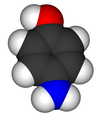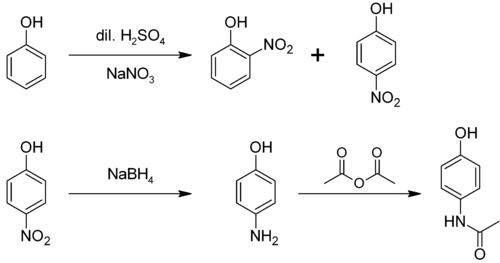4-Aminophenol
| |||
| Names | |||
|---|---|---|---|
| IUPAC name
4-Aminophenol | |||
| Identifiers | |||
| 123-30-8 | |||
| ChEBI | CHEBI:17602 | ||
| ChEMBL | ChEMBL1142 | ||
| ChemSpider | 392 | ||
| |||
| Jmol-3D images | Image Image | ||
| KEGG | C02372 | ||
| MeSH | Aminophenols | ||
| PubChem | 403 | ||
| |||
| UNII | R7P8FRP05V | ||
| Properties | |||
| C6H7NO | |||
| Molar mass | 109.126 g/mol | ||
| Appearance | colorless to reddish-yellow crystals | ||
| Density | 1.13 g/cm3 | ||
| Melting point | 187.5 °C (369.5 °F; 460.6 K) | ||
| Boiling point | 284 °C (543 °F; 557 K) | ||
| 1.5 g/100 mL (25 °C) | |||
| Solubility | very soluble in dimethylsulfoxide soluble in acetonitrile ethyl acetate acetone slightly soluble in toluene, diethyl ether, ethanol negligible in benzene, chloroform | ||
| log P | 0.04 | ||
| Acidity (pKa) | 5.48 | ||
| Structure | |||
| Crystal structure | orthorhombic | ||
| Thermochemistry | |||
| Std enthalpy of formation (ΔfH |
-190.6 kJ/mol | ||
| Hazards | |||
| EU Index | 616-003-00-0 | ||
| EU classification | Carc. Cat. 2 Muta. Cat. 2 Repr. Cat. 3 Toxic (T) | ||
| R-phrases | R20/21, R22, R40 R52, R54, R68 | ||
| S-phrases | S28, S36, S37 S60, S61 | ||
| NFPA 704 | |||
| Flash point | 195 °C (383 °F; 468 K) (cc) | ||
| LD50 (Median lethal dose) |
671 mg/kg | ||
| Related compounds | |||
| Related aminophenols |
2-Aminophenol 3-Aminophenol | ||
| Related compounds |
Aniline Phenol | ||
| Except where noted otherwise, data is given for materials in their standard state (at 25 °C (77 °F), 100 kPa) | |||
| | |||
| Infobox references | |||
4-Aminophenol (or para-aminophenol or p-aminophenol) is the organic compound with the formula H2NC6H4OH. Typically available as a white powder,[1] it is commonly used as a developer in black-and-white film, marketed under the name Rodinal.
Reflecting its slight hydrophilic character, the white powder is moderately soluble in alcohols and can be recrystallised from hot water. In the presence of base, it oxidizes readily. The N-methyl and N,N-dimethyl derivatives are of commercial value.
The compound is one of three isomeric aminophenols, the other two being 2-aminophenol and 3-aminophenol.
Preparation
From phenol
It is produced from phenol by nitration followed by reduction with iron. Alternatively, the partial hydrogenation of nitrobenzene affords phenylhydroxylamine, which rearranges primarily to 4-aminophenol:[2]
- C6H5NO2 + 2 H2 → C6H5NHOH + H2O
- C6H5NHOH → HOC6H4NH2
From nitrobenzene
It can be produced from nitrobenzene by electrolytic conversion to phenylhydroxylamine, which spontaneously rearranges to 4-aminophenol.[3]
Uses
p-Aminophenol is a building block compound. Prominently, it is the final intermediate in the industrial synthesis of paracetamol. Treating p-aminophenol with acetic anhydride gives paracetamol:[4][5][6]
See also
- Metol is the N-methyl derivative of p-aminophenol. In 1891 it replaced p-aminophenol as a developing agent for black & white photography.
References
- ↑ CRC Handbook of Chemistry and Physics 65th Ed.
- ↑ Mitchell, S.C. & Waring, R.H. "Aminophenols." In Ullmann’s Encyclopedia of Industrial Chemistry; 2002 Wiley-VCH, doi:10.1002/14356007.a02_099
- ↑
- ↑ Ellis, Frank (2002). Paracetamol: a curriculum resource. Cambridge: Royal Society of Chemistry. ISBN 0-85404-375-6.
- ↑ Anthony S. Travis (2007). "Manufacture and uses of the anilines: A vast array of processes and products". In Zvi Rappoport. The chemistry of Anilines Part 1. Wiley. p. 764. ISBN 978-0-470-87171-3.
- ↑ Elmar Friderichs, Thomas Christoph, Helmut Buschmann (2005), "Analgesics and Antipyretics", Ullmann's Encyclopedia of Industrial Chemistry, Weinheim: Wiley-VCH, doi:10.1002/14356007.a02_269.pub2



